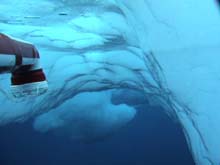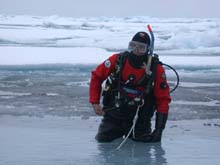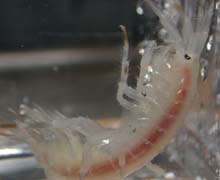
A channel of water between ice keels of several meters depth. (Photo courtesy of Rolf Gradinger.) Click image for larger view.

Diving under the ice has to follow very strict security regulations and should be done only by very experienced divers. (Photo courtesy of Rolf Gradinger.) Click image for larger view.

Gammarus wilkitzkii, a large carnivorous under-ice amphipod, is found in many locations all over the high Arctic and spends its whole life associated with sea ice. (Photo courtesy of Rolf Gradinger.) Click image for larger view.
Sea Ice Sampling
August 26, 2002
Rolf Gradinger
University of Alaska Fairbanks
![]() Observe the hidden realm beneath the ice. (mp4, 2.7 MB)
Observe the hidden realm beneath the ice. (mp4, 2.7 MB)
![]() Despite the barren appearance of pack ice, it actually teems with fascinating organisms that are not visible. (mp4, 3.5 MB)
Despite the barren appearance of pack ice, it actually teems with fascinating organisms that are not visible. (mp4, 3.5 MB)
The Louis has been in and around the Arctic ice nearly all the time since we left Kugluktuk. Signs of macroscopic life have been scarce so far. Today I saw a lone polar bear swimming between ice floes. It then leapt onto a floe, leaving his footprints on degrading summer ice. Two ivory gulls and one kittiwake passed by the ship – that was all. Since we see so few larger animals, it is hard to imagine that we are surrounded by millions of organisms living with the ice. The goal of the sea ice ecological group is to learn more about the incredible life associated with sea ice.
Our main tool used to collect samples of ice-inhabiting animals and plants is called an ice corer. With it, we can drill into the ice surface and cut away a long cylinder of ice about 9 cm in diameter. The length of the sample equals the thickness of the ice. Because August and September are the months of summer melt, sampling sea ice can be logistically difficult. More than half of the surface of the ice is currently covered with shallow melt water puddles. The ice itself is very porous and rotten, full of channels and crevasses, which could easily open below our feet. Ship logistics put other constraints on our activities, so that we spend some days on eight-hour-standby without any success.
We have learned that using a small boat—a Zodiak Fast Recovery Craft (FRC)—is the easiest way to get ice samples under these conditions. The dive team provides us with video observations from the bottom side of the ice floes. A video camera is mounted in an underwater housing, and the divers swim line transects of about 30 m in length recording any animals and structures they encounter during their 20-minute dive.
The under-ice morphology is impressive. Ice thickness changes from a few decimeters to more than 4 m within a few meters distance. The thin ice areas produce arcs of light, contrasting with dark sediment layers. We have not observed any considerable greenish or dark brown algal aggregations, which are typical in early spring and fall. So far, the number of animals within this summer ice has been very low. We do, however, see patchy aggregations of under-ice amphipods—crustaceans that are contained to sea ice and are only found in the Arctic Ocean. Today, one of the divers caught two specimens of Gammarus wilkitzkii. These creatures, each about 6 cm long, are the largest under-ice amphipod species in the Arctic. This carnivorous amphipod clings to the ice underside in an upside down manner using specially shaped legs for attachment.
All the information gathered on sea ice will help us in two ways. First, it will foster our understanding of Arctic sea ice with regard to both ecology of individual ice-associated species and climate change relevant issues. Second, the under-ice investigations made possible by our divers will help us improve sampling strategies for future expeditions related to life in and on the ice.
Sign up for the Ocean Explorer E-mail Update List.


























